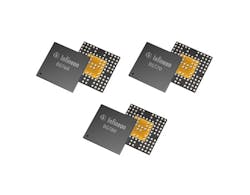Mobile communications systems, such as fourth-generation Long-Term-Evolution (4G LTE) cellular systems, rely on higher-frequency point-to-point links for passing information between base stations. Nowadays, these backhaul links tend to make use of the generous bandwidths available at millimeter-wave frequencies. A trio of front-end integrated circuits (ICs) in the BGTx0 family from Infineon Technologies provide transmit and receive functions in the three backhaul frequency ranges of 60, 70, and 80 GHz to ease the construction of broadband backhaul links in modern wireless communications systems.
Related Articles
• 1-V Transceiver Exceeds Needs Of IEEE 802.15.6 Narrowband/BLE PHY
• Modular SoC Design Integrates RF Transceiver In 32-nm Process
• Q-Band Transceiver Makes MIMO Links
The three millimeter-wave ICs (see figure) are the model BGT60 for use at V-band frequencies (57 to 65 GHz); model BGT70 for 71 to 76 GHz; and model BGT80 for E-band frequencies (81 to 88 GHz). The ICs are based on the firm’s silicon-germanium (SiGe) device technology, which is characterized by a transition frequency (ft) of 200 GHz. This SiGe technology has been well proven and qualified in the company’s lines of millimeter-wave chipsets for 24- and 77-GHz automotive-radar systems.
The BGTx0 family of devices integrate critical receiver and transmitter functions—such as programmable gain amplifiers (PGAs), low-noise amplifiers (LNAs), power amplifiers (PAs), a serial peripheral interface (SPI) control interface, an in-phase/quadrature (I/Q) modulator/demodulator, and voltage-controlled oscillators (VCOs)—into a single chip operating at efficient power levels. At millimeter-wave frequencies, the devices offer as much as +18 dBm PA output power, 6-dB LNA noise figure, and VCO phase noise of better than -85 dBc/Hz offset 100 kHz from the carrier.
The devices can operate in transmit or receive modes by control with their SPI bus. The three chips feature identical footprints and package pin configurations; they employ a direct-conversion, zero-intermediate-frequency (zero-IF) transceiver configuration for simple connection to modern modems and baseband circuitry, without the need for external filtering. Since the packages and layouts are the same, similar design approaches can be used with the different ICs to accommodate the backhaul requirements of different communications systems at different frequencies.
These millimeter-wave transceiver ICs provide much-needed backhaul communications bandwidths between cellular base stations by making use of 10 GHz of bandwidth at E-band frequencies from 71 to 76 GHz and 81 to 86 GHz, as well as 7 GHz of bandwidth at V-band frequencies from 57 to 64 GHz. Originally, connections between cellular base stations were planned for data rates in the neighborhood of 100 Mb/s. But the increasing transmission of video and large data files has taxed the initial system requirements and created the need for the wider bandwidths available at millimeter-wave frequencies. By using these V- and E-band frequencies, 4G cellular systems can provide data rates in excess of 1 Gb/s between cell sites and core network equipment.
According to Philipp von Schierstaedt, Vice President and General Manager of Infineon’s RF & Protection Devices business line, “The V- and E-band microwave frequencies available for LTE/4G backhaul support data rates three times higher than in earlier-generation networks. Correspondingly, they need superior RF performance to meet operating requirements.” He adds that “with this new transceiver family, Infineon leverages its process technology and RF design leadership to help system designers reduce complexity, simplify their production logistics, and ultimately improve quality and field reliability of their backhaul connectivity solutions.”
The millimeter-wave transceivers are supplied in compact plastic embedded wafer level ball-grid-array (eWLB) packages that support a standard surface-mount-technology (SMT) production-line assembly flow. Each transceiver can replace more than 10 discrete devices with a single IC and, with their low (less than 2 W) power consumption, can contribute to lower operating costs in high-data-rate backhaul links. Engineering samples of the devices will be available in September 2013.
Infineon Technologies North America Corp., 640 N. McCarthy Blvd., Milpitas, CA 95035; (866) 951-9519; www.infineon.com.
About the Author
Jack Browne
Technical Contributor
Jack Browne, Technical Contributor, has worked in technical publishing for over 30 years. He managed the content and production of three technical journals while at the American Institute of Physics, including Medical Physics and the Journal of Vacuum Science & Technology. He has been a Publisher and Editor for Penton Media, started the firm’s Wireless Symposium & Exhibition trade show in 1993, and currently serves as Technical Contributor for that company's Microwaves & RF magazine. Browne, who holds a BS in Mathematics from City College of New York and BA degrees in English and Philosophy from Fordham University, is a member of the IEEE.
